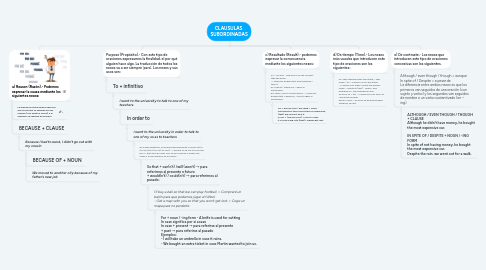
1. a) Reason (Razón).- Podemos expresar la causa mediante los siguientes nexos:
1.1. La diferencia entre ambos nexos es que el primero va seguido de una oración (con sujeto y verbo) y el segundo va seguido de nombre.
1.2. BECAUSE + CLAUSE
1.2.1. Because I had to work, I didn't go out with my cousin
1.2.1.1. BECAUSE OF + NOUN
1.2.1.2. We moved to another city because of my father’s new job
2. Purpose (Propósito).- Con este tipo de oraciones expresamos la finalidad, el por qué alguien hace algo. La traducción de todos los nexos va a ser siempre ‘para’. Los nexos y sus usos son:
2.1. To + infinitivo
2.1.1. I went to the university to talk to one of my teachers.
2.1.1.1. In order to
2.1.1.1.1. I went to the university in order to talk to one of my so as to teachers
3. c) Resultado (Result).- podemos expresar la consecuencia mediante los siguientes nexos:
3.1. So = así que - She was ill so she couldn’t take the exam. - I failed my English test and therefore I took it As a result / therefore = again in September. por tanto, como consecuencia - I failed my English test. Therefore, I took it again in September.
3.1.1. SO + ADJECTIVE / ADVERB + THAT The ticket for the concert was so expensive (that) we couldn’t buy it. SUCH + (ADJECTIVE) + NOUN THAT It is such a big city (that) I always get lost.
4. d) De tiempo (Time).- Los nexos más usuales que introducen este tipo de oraciones son los siguientes:
4.1. As I was walking down the street, I saw When / as = cuando my ex-boyfriend. - I’ll phone you when I know the answer While = mientras (que) - While I was watching TV, the telephone rang. As soon as = tan - I’ll phone you as soon as I know the answer. pronto como - As soon as he had finished studying, he left.
5. e) De contraste.- Los nexos que introducen este tipo de oraciones concesivas son los siguientes.
5.1. Although / even though / though = aunque In spite of / Despite = a pesar de La diferencia entre ambos nexos es que los primeros van seguidos de una oración (con sujeto y verbo) y los segundos van seguidos de nombre o un verbo sustantivado (en – ing).
5.1.1. ALTHOUGH / EVEN THOUGH / THOUGH + CLAUSE Although he didn’t have money, he bought the most expensive car. IN SPITE OF / DESPITE + NOUN / -ING FORM In spite of not having money, he bought the most expensive car. Despite the rain, we went out for a walk.

